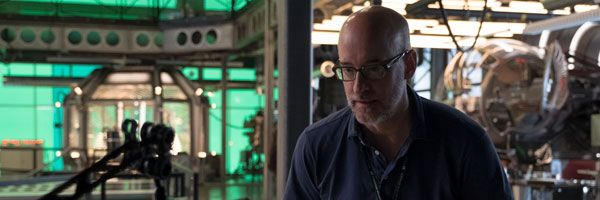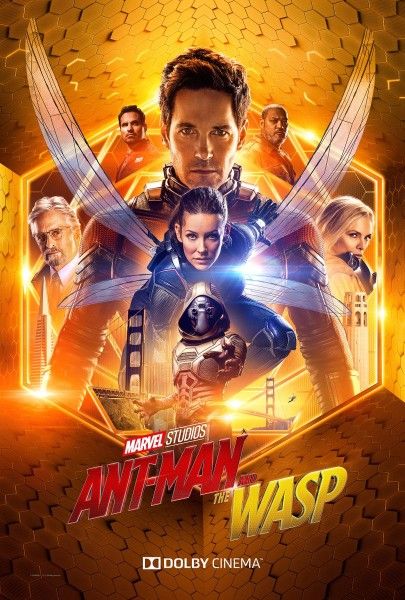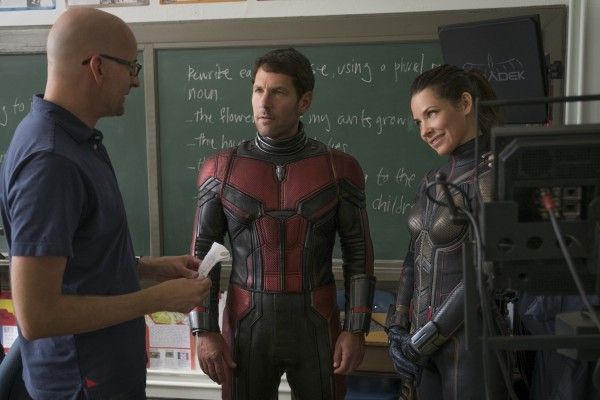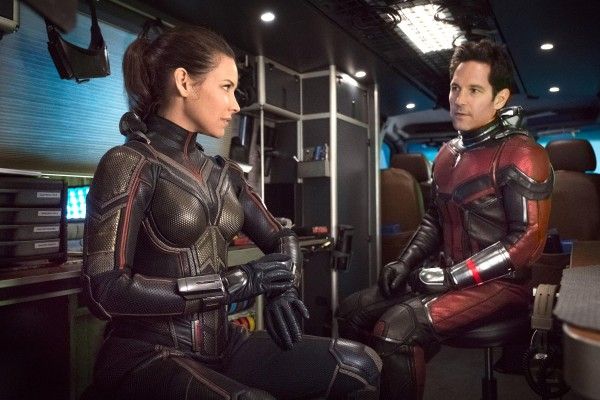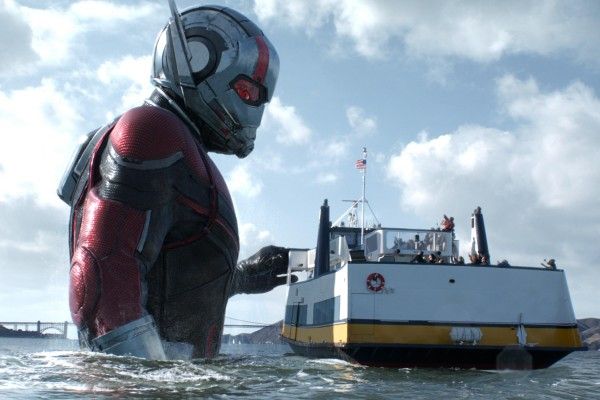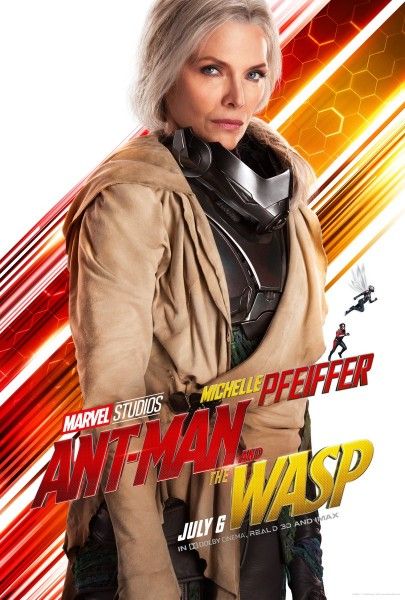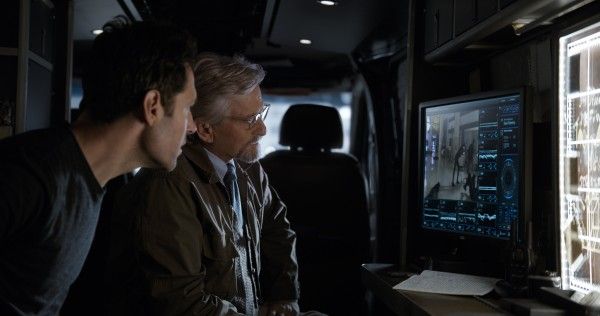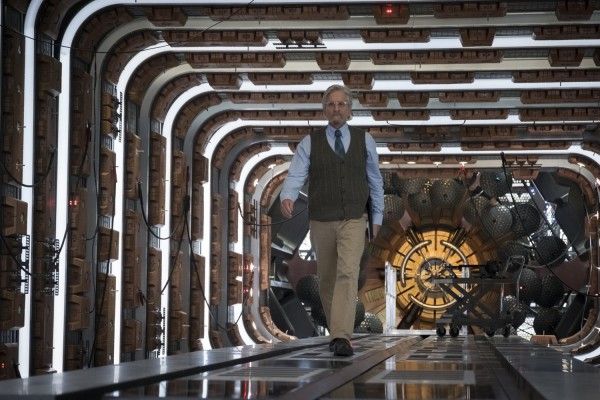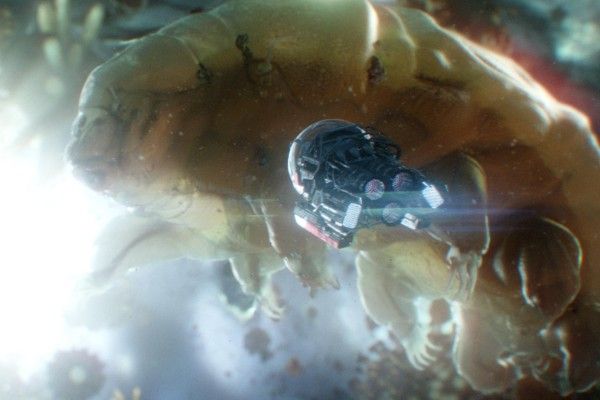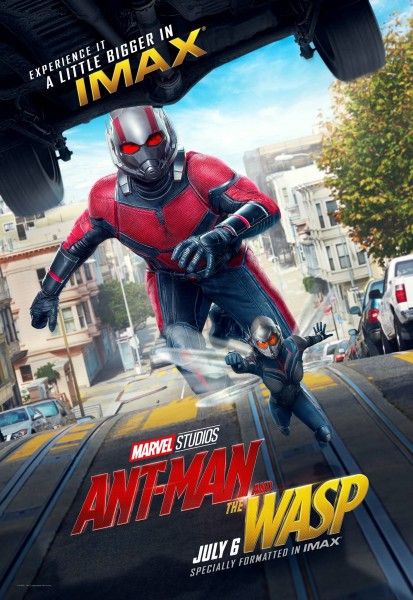Back in September 2017, I had the opportunity to visit the Atlanta, Georgia set of Ant-Man and the Wasp. You can check out a full rundown of the “things to know” from the visit right here, but right now we’re putting the spotlight on director Peyton Reed. Remember when all hope was seemingly lost when Edgar Wright exited the first Ant-Man back in May 2014? Well, it turns out, Reed was a rock solid replacement and ushered Scott Lang (Paul Rudd) into the Marvel Cinematic Universe in a film packed with heart, humor and an abundance of very clever set-pieces putting Hank Pym's (Michael Douglas) shrinking technology to use. But now the question is, can he do it again? There’s tons of pressure on any new MCU installment but this is the first film after the game-changing Avengers: Infinity War.
We’ve got to wait until July 6th to see if Reed and his team pulled it off, but for now, we’ve got a ton of Ant-Man and the Wasp story details for you, straight from Reed himself. He addressed the pressure of following up Infinity War and also offered up some information on the main villain of the film, how the events of Captain America: Civil War affect Scott, Hank and Hope (Evangeline Lilly), he shares some information on Laurence Fishburne’s character, Bill Foster, and also teases the importance of the mission to track down Janet van Dyne (Michelle Pfeiffer) in the story. You can read about all of that and much more in the interview below.
Why’d you go with Cherry Blue for the production title?
PEYTON REED: Cherry Blue is a nod to a Tim and Eric sketch where Dr. Steve Brule's going to buy a car. Do you know the sketch? And he wants a cherry red car and they only have cherry blue so for some reason that … It felt like something you'd see with the logo spray-painted on the side of a van. For some reason it felt appropriate.
And the Paul [Rudd] connection to Tim and Eric.
REED: Exactly, yeah. But just, it felt right for the vibe of our movie.
Can you talk a little bit about the idea of making it a ticking clock story? We keep hearing “one crazy night.”
REED: In terms of when we first started talking about what Ant-Man and the Wasp would look and feel like, and the kind of movie we wanted to make, I definitely started talking about things like After Hours and Midnight Run, and these things where there's a lot of forward momentum. There’s almost a road movie quality to the movie in that way.
The first movie, because it was an origin story, a lot of it took place in Hank Pym's house and these things, and I just wanted to open the movie up and get out and take advantage of San Francisco because that felt like a different texture for the MCU that Ant-Man sort of occupies this corner of the universe and we wanted to really get outside and explore those elements.
And the urgency was really about trying to graph this idea of sort of a search-and-rescue movie onto that, where there was this ticking clock and for whatever scientific reasons, if they were going to go, perhaps, look for Janet van Dyne, how do you go about doing that? It's an impossible thing scientifically, but also if there's urgency and there's maybe a window of time they have to do it. It's about collecting the people, the things, everything they need to do that.
The first movie, really, the template was more of a heist movie and this wanted to be a little more of like an Elmore Leonard vibe where we have villains, but we also have antagonists, and we have these roadblocks to our heroes getting to where they need to be, and getting what they need for this mission. It felt like this sort of, little more chaotic comedy and action in the movie felt like a good next step for Ant-Man and the Wasp. And, I also really like that when you're doing a sequel or a next movie, I always like the ones where the starting off point, the jumping off point for the characters is different than when you left them. And again, I know that everyone who's ever made a second installment of something refers to The Empire Strikes Back as the gold standard, but as a kid, I was 16 when that movie came out, and I loved that they really leapt ahead. The heroes are somewhere else now and the audience has to kind of catch up to what's going on and what happened, and they’re forwarded in terms of their character, but also in terms of their circumstances and that felt like something we really wanted to do.
It also felt like because of what happened with Scott Lang in the brief time he's in Civil War, we couldn't ignore those circumstances and for our jumping off point, my first questions were - what did Hank and Hope know about Scott going off and dealing with that situation with The Avengers and did they know about it? How did they feel about it? And surely this would've caused some kind of tension at worst and rift at best between the characters because Hank Pym's very clear in the first movie about how he feels about Stark and how he feels about The Avengers and being very protective of this technology that he has. So that seemed like a really ripe sort of place to start in terms of character development.
What we see in the Marvel Cinematic Universe compared to most other franchises is that, we've not only seen Civil War, but we will see a lot of other events happen within this universe. How do you wind up working that into what you're doing here?
REED: As I said, we definitely had to deal with the ramifications post Civil War. That was crucial to Scott. And crucial to Hope. I mean it really is like fundamental in the jumping off point about what's going on between the two of them at the start of this movie. Outside of that, what I'm really happy about is, we're free to tell sort of our free-standing story. Once we establish that as the leaping off point, this thing is going on over here with huge personal stakes and huge other stakes that are really separate of what's going on with Infinity War. So that again is something that was really, really, appealing to me. We have enough stuff to track in this movie without having to sort of keep up with the rest of what's going on with that.
Can you talk about the challenges of having to essentially share a ball with this neighboring production, [Avengers 4]?
REED: Scheduling wise, you know, it's a challenge, but it's a challenge we knew was going to be there. It's made easier obviously by the fact that we're all down here on this Pinewood campus, all working together. So there’s, you know, behind the scenes shuffling and scheduling stuff but so far, it hasn't impacted us. I know in October there's some big dates coming up for Paul but so far, it's been fine. So far, I have not felt the impact of the other movie.
You know, for the first movie, we came out in the wake of Avengers: Age of Ultron, which was, you know - that was the sequel to Avengers! It's Age of Ultron! So we could kind of be working in this little corner, and it feels the same way again because now we're coming out right after Infinity War. And again, I like that. I personally feel that's the position I want to be in. I mean, it's good.
Can you talk about the responsibility and urge to boost Hope's character and The Wasp, and make it a two-hander, give her agency, and kind of show who she is without Ant-Man and without her dad?
REED: Absolutely. That was something that again, from the get-go, particularly when we decided that this movie was going to be Ant-Man and The Wasp - it's not Ant-Man with The Wasp, it's Ant-Man and the Wasp. And so it is important to tell those stories separately and invest in each of the character’s journey and arc in the movie.
And one of the big things about this is kind of what's going on with Hope and the fact that she has - let me be delicate so I don't give anything away - the mission that is happening with her, entirely separate of Scott, is vital. And it's her mission. It's not her dad's mission. It's her mission. Hank and Hope are working together, but it's really Hope leading in charge, and that was an important thing when we started talking about what was going on, is the what and why of this mission. And that there may be certain points in this movie where she sees Scott as a liability. And I think that was important because you know, there are aspects of this movie that are like, you know, a two-hander action movie. There's aspects of it that are like a two-hander romantic comedy. And for me, who's done a little bit of both, it's important to sort of get that balance and have her be, you know, a fully fleshed out character with motivations.
The other questions we talked about, you know with the search and rescue aspect is, if it is trying to find Janet van Dyne, what does that mean to Hope? We kind of know what it means to Hank from the first movie, but what does it mean to Hope? And, if she's now finally a fully fledged hero in her own right, and you're in a position like that, you know, you tend to kind of look for mentors or role models, and the one person that she would really turn to is not there. Hank can do something, Scott maybe might be a template for maybe what not to do all the time [laughs], but that person who really I think she ideally would want there is not there, and that was a really important aspect of the movie.
Can you talk about what the main mission of this movie is? We've heard a lot about, ‘Oh, there's a bunch of antagonists, there's a bunch of villains, there's a mission to contact Janet.’ When you guys promote the movie, is it primarily going to be that mission to find her or is there some sort of big bad?
REED: Well, I'll answer that in two parts. The big mission is to find Janet. What that means ultimately for our characters on a personal level is one thing. What it means for the larger world is another thing. And all the other things are really, you know, stumbling blocks on the path. There is a big bad that has a very unique relationship to our characters. And I know you know that the character Ghost is in the movie, and that we've adapted the character from the comics in a way that we feel is really unique to our movie, and very much tied into this universe. So, she becomes a really, really crucial part of the story in a way that I can't really reveal yet. Thank you very much.
Something the first movie did that is really unique to you guys from many of the other Marvel movies, but is still very rooted in the comic books, is the idea of a legacy hero. How do you continue to build on that?
REED: Well, yeah. We deal with it really head-on in the movie, because I think the thing that we deal with more in this movie is maybe the disappointment of the mentor. The first movie is all about, ‘I have this technology and what happens to it? I'm too old to deal with this now, and to whom do I bequeath this to?’ In the first movie, the answer is right in front of his face the whole time - it's Hope. He chooses for his own particular reasons to go outside the box. That is all about accepting the responsibility of this incredibly powerful technology. But, after the events of Civil War, Scott has proven to be somewhat unreliable in that regard. So, that's a big character thrust in this movie is a mentor who maybe is questioning his decision in a big, big way.
[Production designer] Shepherd [Frankel] said we needed to ask you specifically about the quantum realm, the design of that and what inspired it.
Reed: Well, when we started talking about the quantum realm, it's problematic in terms of the fact that it's essentially infinite. It can be whatever you want it to be. And so, we needed to decide sort of what the quantum realm wants to be for our story, and then what it is in sort of the larger sense of things. I knew one thing about [the quantum realm] - there had to be a device with which they enter the quantum realm. In the first movie, Scott goes down and he adjusts the regulator, and goes down just free fall. Here, it needed to be bigger. It needed to be something that was not a game-time decision and not accidental, but something very, very, constructed and purposeful.
And one of the things that I went back and looked at as inspiration was Irwin Allen's The Time Tunnel. I was really little when that show - I'm sure I saw it in reruns, and my older brother saw it, but there was a design for that thing, which was literally a tunnel, and I liked the idea of amidst all this stuff, that there was a physical thing that you could look at. Something that physically, sort of, without any action happening, you could look at and say, ‘Okay, I get a sense of what that thing does.’
And so Shepherd forwarded the design and refined it in a way that's fantastic. And I think that's another thing that I'm really psyched about with this movie that a lot of times with these movies, in the digital age, it's actors acting against a green screen and I was insistent, because I still feel from the first movie, and even more so in this movie that there's a really tactile quality to the Ant-Man and Wasp universe. That you want to feel that stuff. So the set that you'll go on, I think is really the biggest set that's ever been constructed for a Marvel movie. In terms of just being a tactile set. You'll see on the side, there's some green screen extensions that we're doing top and bottom and whatever, but it's already for me - it pays big dividends when you have the actors in there and they can react to something physical.
The first time we brought Paul, Evangeline, and Michael onto the set, you know, we hadn't showed them anything. We brought them on with the thing finished and to see their reactions, and see the joy of like, ‘Here's a set that we can really move around in.’ We've designed it obviously to shoot, but you're still limited by physical space, and the camera can do certain things, and they have to move around things, and it lends this whole air of reality to it. These movies, just by their nature, have a lot of visual effects, but the more you can have tactile stuff.
Part of the set, you'll see, is the quantum vehicle, the pod they go down in. And that was another thing that felt like you know, if I'm a kid, I want to play with this thing. It's gotta be functional. You look at this thing, and you'll be able to sort of scrutinize it down there, but you really see this is designed by Shepherd and constructed with Dan Sudick, our special effects guy. But it really feels like, ‘Oh, okay, I could get in that thing and head down there.’ So the tactile quality was really important.
Can you talk a bit about the Bill Foster character? Is he a friend or a foe? I know he's a hero in the comics, but my head is spinning with the suggestions that he’s a former assistant and colleague of Hank. And clearly we haven't heard about Bill Foster so far, so is he really there to help Hank Pym or is he a possible foe?
REED: Yeah, you're right. Bill is a former colleague who really was involved early on with Pym in a thing called Project Goliath. And, their lives have taken these kind of divergent paths, and when we find Bill Foster in this movie, he is teaching quantum physics at Berkeley. I also liked the idea of grounding, because the movie takes place in San Francisco, and it's not just for stunts and scenery. Like Berkeley, that's an important thing in the movie is that they were both involved with SHIELD at some point, but one guy sort of stepped away and taken a more academic approach.
I liked the idea from the beginning, especially having Michael and Laurence Fishburne, of these guys who are sort of scientific rivals. That's really their rivalry, and we always talked about sort of a Steve Jobs, Bill Gates kind of thing. Two scientists who are both geniuses in quantum physics and quantum mechanics, but maybe have a Mac, PC rivalry about what the approach to delving into the quantum realm might be. I also liked the idea with those two actors, especially with Fishburne, like someone who is gonna actually go toe-to-toe with Michael in terms of who's the smartest guy in the room? That struck me as something really fun, to give Hank Pym a foil in this movie in that way.
For even more from our Ant-Man and the Wasp set visit, you can browse the links below:
- 'Ant-Man and the Wasp': 22 Things to Know about the 'Midnight Run'-inspired Sequel
- Evangeline Lilly on the Very Different Hope van Dyne We'll See in 'Ant-Man and the Wasp'
- ‘Ant-Man and the Wasp’ Set Visit: Everything We Learned about the Quantum Realm
- Here’s How ‘Ant-Man and the Wasp’ Fits into the MCU Timeline

